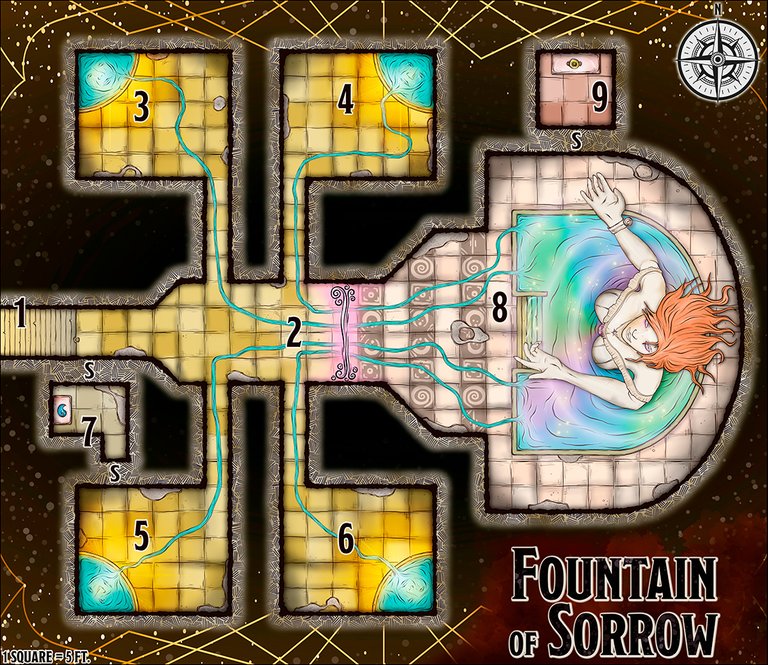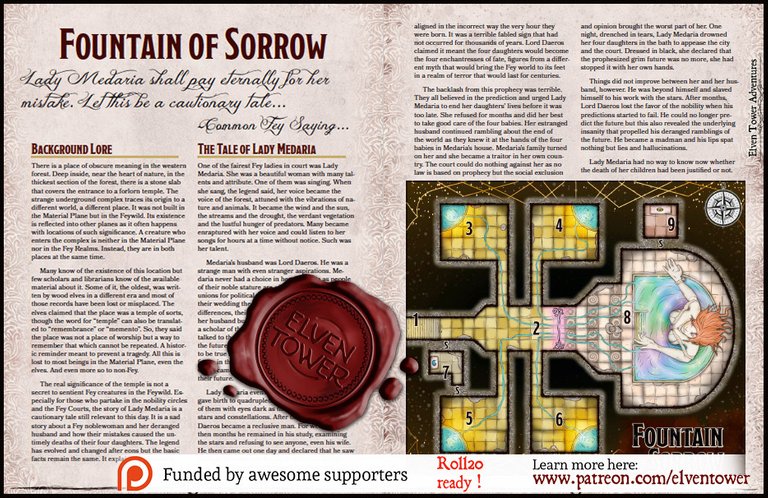Background Lore
There is a place of obscure meaning in the western forest. Deep inside, near the heart of nature, in the thickest section of the forest, there is a stone slab that covers the entrance to a forlorn temple. The strange underground complex traces its origin to a different world, a different place. It was not built in the Material Plane but in the Feywild. Its existence is reflected into other planes as it often happens with locations of such significance. A creature who enters the complex is neither in the Material Plane nor in the Fey Realms. Instead, they are in both places at the same time.
Many know of the existence of this location but few scholars and librarians know of the available material about it. Some of it, the oldest, was written by wood elves in a different era and most of those records have been lost or misplaced. The elves claimed that the place was a temple of sorts, though the word for “temple” can also be translated to “remembrance” or “memento”. So, they said the place was not a place of worship but a way to remember that which cannot be repeated. A historic reminder meant to prevent a tragedy. All this is lost to most beings in the Material Plane, even the elves. And even more so to non-Fey.
The real significance of the temple is not a secret to sentient Fey creatures in the Feywild. Especially for those who partake in the nobility circles and the Fey Courts, the story of Lady Medaria is a cautionary tale still relevant to this day. It is a sad story about a Fey noblewoman and her deranged husband and how their mistakes caused the untimely deaths of their four daughters. The legend has evolved and changed after eons but the basic facts remain the same. It explains the following.
The Tale of Lady Medaria
One of the fairest Fey ladies in court was Lady Medaria. She was a beautiful woman with many talents and attribute. One of them was singing. When she sang, the legend said, her voice became the voice of the forest, attuned with the vibrations of nature and animals. It became the wind and the sun, the streams and the drought, the verdant vegetation and the lustful hunger of predators. Many became enraptured with her voice and could listen to her songs for hours at a time without notice. Such was her talent.
Medaria’s husband was Lord Daeros. He was a strange man with even stranger aspirations. Medaria never had a choice in her marriage as people of their noble stature are often caught in arranged unions for political gain. Her parents agreed on their wedding the day she was born. Despite such differences, their union worked. She did not love her husband but respected him. Lord Daeros was a scholar of the skies. An analyst and prophet who talked to the stars and came back with insight from the future. His predictions on many subjects came to be true most of the time and he was a respected figure in the community. Many members of the Fey Court came to him for private audiences to know their future.
Lady Medaria eventually became pregnant and gave birth to quadruplets. Four beautiful girls, all of them with eyes dark as the night skies, full with stars and constellations. After they were born, Lord Daeros became a reclusive man. For weeks and then months he remained in his study, examining the stars and refusing to see anyone, even his wife. He then came out one day and declared that he saw a dangerous omen in the birth of his four daughters. The stars were wrong and three constellations aligned in the incorrect way the very hour they were born. It was a terrible fabled sign that had not occurred for thousands of years. Lord Daeros claimed it meant the four daughters would become the four enchantresses of fate, figures from a different myth that would bring the Fey world to its feet in a realm of terror that would last for centuries.
The backlash from this prophecy was terrible. They all believed in the prediction and urged Lady Medaria to end her daughters' lives before it was too late. She refused for months and did her best to take good care of the four babies. Her estranged husband continued rambling about the end of the world as they knew it at the hands of the four babies in Medaria's house. Medaria's family turned on her and she became a traitor in her own country. The court could do nothing against her as no law is based on prophecy but the social exclusion and opinion brought the worst part of her. One night, drenched in tears, Lady Medaria drowned her four daughters in the bath to appease the city and the court. Dressed in black, she declared that the prophesized grim future was no more, she had stopped it with her own hands.
Things did not improve between her and her husband, however. He was beyond himself and slaved himself to his work with the stars. After months, Lord Daeros lost the favor of the nobility when his predictions started to fail. He could no longer predict the future but this also revealed the underlying insanity that propelled his deranged ramblings of the future. He became a madman and his lips spat nothing but lies and hallucinations.
Lady Medaria had no way to know now whether the death of her children had been justified or not. Perhaps it would have been better if Daeros' predictions had been wrong all along, she would have someone to blame in that case. But there was no way to know when the failed prophet had lost the gift of foresight. The very real possibility that Lady Medaria had killed her infants in vain destroyed her. She cried until her throat was sore from the effort and she lost her singing voice. And then she kept on crying until the room was flooded with her tears and she drowned in her own guilt and sorrow.
Fountain of Sorrow
The temple in the forest is a reminder to all Fey in court to consider the severity of a prophet’s prediction lest they have lost the gift of foresight. Inside the temple, a large statue of Lady Medaria rises from a pool of tears. In different chambers, four smaller ponds represent each of her dead daughters. The souls of the infants are tied to the pools for eternity. They cry for their mother’s mistakes and their own untimely deaths. Their tears form streams that feed the large pool. The daughters’ tears feed the pool with sorrow, guilt, and blame.

Area Descriptions
1. Entrance
A long stretch of stairs under a stone slab leads down to the temple. It descends 60-feet into the earth and leads to a large hallway with four exits. The end opposite to the entrance features a strange misty barrier. A successful DC 18 Intelligence (Investigation) check at the base of the stairs reveals the presence of a hidden passage on the south wall. Pushing two stone bricks simultaneously causes a portion of the wall to slide sideways and reveal a passage to Area 7.
2. The Barrier
A magical barrier of gaseous nature prevents any creature from reaching Area 8. Four narrow streams of water come from each of the rooms and cross the barrier. Upon closer inspection, the liquid is salty and sour.
Most attempts to bypass it fail (see sidebar). A single creature in possession of the tear of Medaria can cross the barrier and face Medaria’s anger alone. Answering the requests of the four smaller ponds or destroying the ghosts gives any creature present the ability to see through and cross the barrier.
3. Pond of Sadness
A round pond by the northwest corner of the chamber is the only thing of notice in the room. Water overflows from the pond's edge and becomes one of the streams that cross the barrier. The water in the pond is in constant erratic movement. An infantile androgynous face is visible on the surface.
The face on the water explains that these are tears of sadness. It will not stop crying until each creature present shares their deepest secret, the one that causes the most sadness in them. The face cannot read minds but it knows when the secret revealed is not the deepest one. If a creature tries to lie or hide this secret, the ghost of the first daughter emerges from the pond in a wild display of madness and attacks. If all secrets are accepted or the ghost is destroyed, the pond becomes calm and the stream of tears stops.
4. Pond of Guilt
The pond is identical to the one in Area 3 but it is located in the northeast corner of the room. The face on the water explains that these are tears of guilt. It will not stop crying until all creatures present offer a moment of remembrance and in full humility, accept the most horrible action they have performed, accept its consequences, and embrace the guilt that arises from it. The face knows if a creature lies or if it displays false humility. If this happens or if someone refuses to participate, the ghost of the second daughter emerges from the water and attacks. If all creatures accept their guilt or the ghost is destroyed, the pond becomes calm and the stream of tears stops.
5. Pond of Regret
The pond is identical to the one in Area 3 but it is located in the northeast corner of the room. The face on the water explains that these are tears of regret. It will not stop crying until all creatures present truly regret any wrongdoing in their past. This is an irrational request that no one can ever hope to achieve. The ghost suffers from eternal damnation and wants all mortals to regret their lives to appease its suffering. The ghost is angry that no one can fulfill its request and attacks. If it is destroyed, the pond becomes calm and the stream of tears stops.
6. Pond of Eternal Remembrance
The pond is identical to the one in Area 3 but it is located in the northeast corner of the room. The face on the water explains that these are tears of remembrance. It will not stop crying until all creatures present agree to drink a sip of tears from the pond. It explains that this will make them sleep to relive the last week of the existence of Lady Medaria. If a creature drinks from the pond, it falls into a deep slumber that lasts for an entire week. During this time, the person experiences the anxiety, guilt, and fear that lead Lady Medaria to drown her children. They experience this is if they were Medaria herself. During this period, they do not suffer the consequences of thirst or hunger. They only way to wake up a person from this sleep is with a break curse spell.
If anyone refuses to drink, the ghost of the fourth daughter attacks. If all creatures experience the long dream or if the ghost is destroyed, the pond becomes calm and the stream of tears stops.
7. The Tear of Medaria
Lady Medaria's first tear after she drowned her children crystallized and became a token of her sorrow. A creature that holds this object can cross the barrier without first appeasing the four ghosts. It cannot be thrown across the barrier so a group cannot abuse this ability to cross the barrier collectively. Only one person can cross.
8. Fountain of Sorrow
A gargantuan statue of a fair woman emerges from the waters in a large pond. The four tear streams empty their remaining tears into the pond. Five stone steps descend into the pool. Upon closer inspection, the tears in the pool are ethereal and there is no way to interact with them. The spirit of Lady Medaria is a prisoner within the statue. For eternity she suffers as her sorrow is fed with the tears of the four ghosts. When any visitors access the chamber, her spirit emerges and is unable to withhold her anger at herself for her own actions.
Medaria's anger manifests in the form of ethereal replicas of herself made from crystallized tears in the pond. These abominations behave like hungry monsters that only wish to destroy and kill. Eight crystal manifestations (ghouls) exit the water and attack. When the crystal manifestations are destroyed, Medaria is restored to a temporary state of normal sentience. She is grateful to whoever freed her from her eternal anger but warns them that her state will revert after only a few hours. She points them to the hidden door to Area 9 where an ancient artifact will allow them to drink from the pond.
9. The Chalice of Restitution
An oversized golden chalice rests atop a stone pedestal. The chalice was used in the Feywild during the naming ceremony of the four daughters. This magical chalice is the only object which can hold the tears from the Fountain of Sorrow.
The tears in the fountain have magical properties. It is possible to drink the tears from this chalice only. When a creature drinks the tears, they are cured of any magical disease or effect that affects them. Otherwise, the spirit of Lady Medaria may bestow a charm or a curse upon the drinker depending on their actions with the four ghosts.
General Features
These are the general features of the Fountain of Sorrow. It located underground. The entrance is in the thickest section of a large forest.
Terrain. Aged stone tiles cover the floor of the temple. They are old and some have cracked from erosion and time. Squares where any of the tear streams pass are considered difficult terrain for the purposes of tactical movement.
The Barrier. Arcane magic materializes on the eastern end of Area 2 and forms a barrier. It appears to be gaseous in nature but it is impassable by most physical and magical means. A wish spell dispels the barrier for one hour. Holding the tear of Medaria (Area 7) allows one person to cross the barrier unimpeded. Answering the requests of the four daughters or destroying her ghosts allows any creature present to cross the barrier and reach the Fountain of Sorrow.
The Ghosts. The ghosts of the four daughters inhabit each pond. If appeased or destroyed, they reform in 1d6 days and continue feeding the barrier and the Fountain of Sorrow. There is no way to remove them from their suffering.
Light. The ponds and streams of tears radiate light. Rooms with a pond are in bright light. Areas with only streams present are in dim-light. Area 9 and Area 7 are in complete darkness.
Smells and Sounds. The streams of tears have a sour and salty smell that propagates throughout the dungeon. The dungeon is in complete silence but a strange magical effect causes visitors to experience slight auditory hallucinations. Laments, cries of help, whispers, and sobbing are audible intermittently and with no apparent source.

I'm a graphic illustrator for tabletop RPG games like Dungeons and Dragons.
If you're interested in my work, take a look at my Patreon page
There is a pledge level that gives access to my photoshop source files, in case you wish to see my workflow and learn in the process.

So excellent.
thanks, I appreciate it
NP - I've got a friend named Florian who wrote a prodigious roleplaying book, but lacks campaigns. Perhaps you ought to collaborate with him, and monetize a project together.
sure thing, I know a guy named Florian in the scene, perhaps we've worked together already!
Florian Stynglmyr "nola"
[email protected]
Hit him up and say that Root sent you -- share what you do. Might be a cool conversation. He's a man with some sincere work ethic and project execution, but not so much monetization. Though I believe that he does small group DM work on a hobby level.
You got to see the book he put together.
This post was shared in the Curation Collective Discord community
community witness. Please consider using one of your witness votes on us here for curators, and upvoted and resteemed by the @c-squared community account after manual review.@c-squared runs a